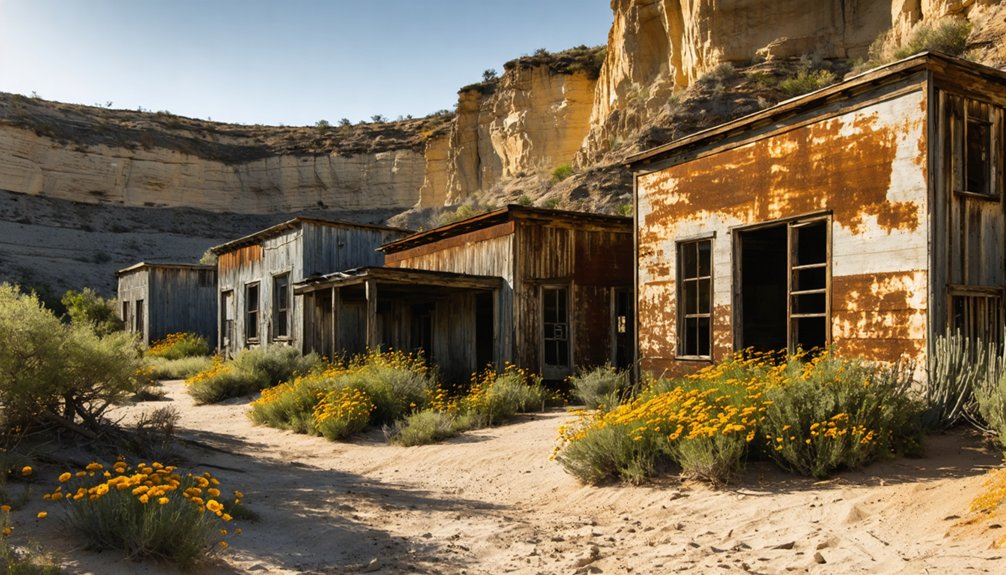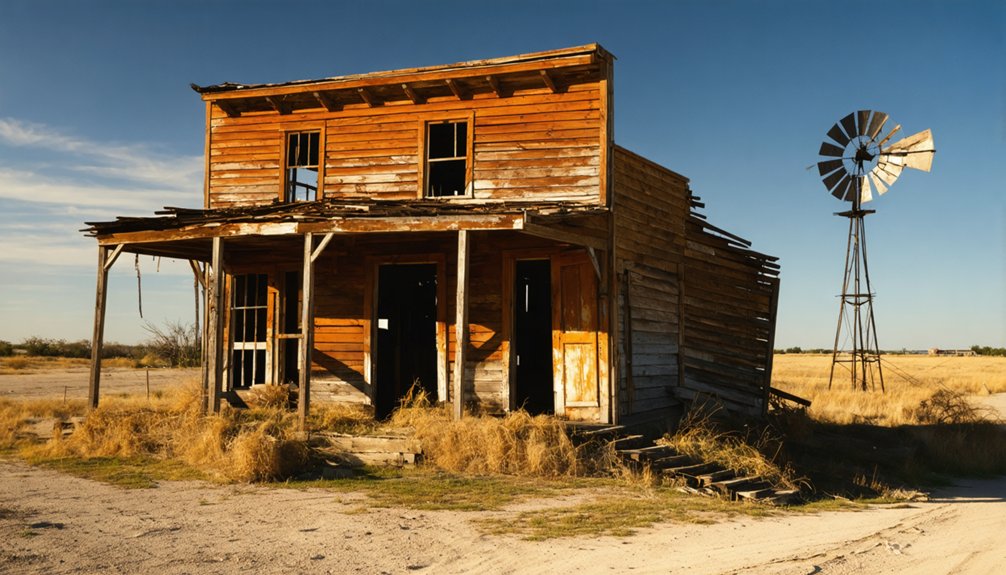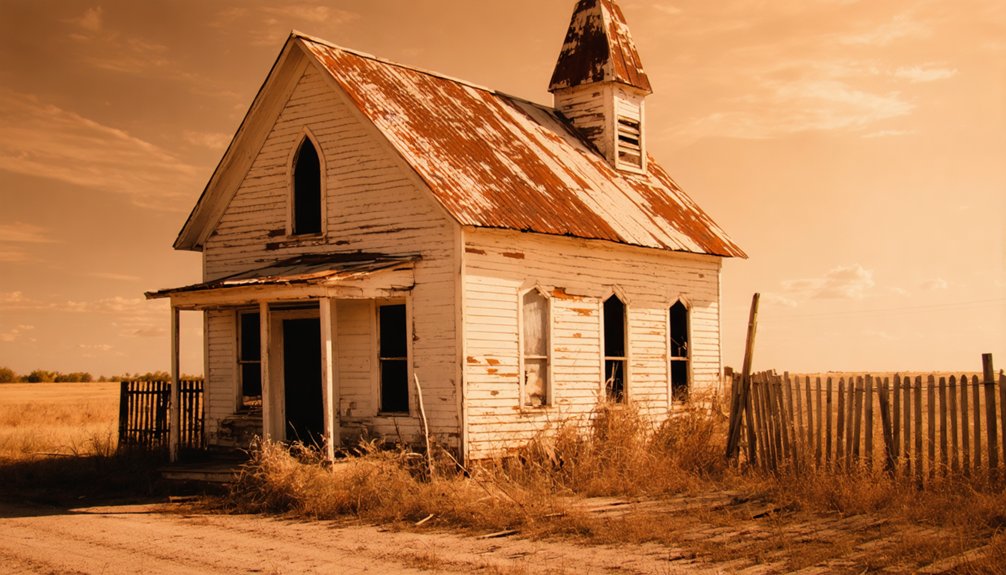You’ll find Sunshine Hill, Texas 33 miles west of Wichita Falls, where a distinctive 1,208-foot hill marks this former settlement’s location. Founded in 1889 as a farming community, it transformed into a bustling oil boomtown in the 1930s when major oil discoveries sparked local drilling. By the 1960s, economic decline led to its abandonment, and today only ruins and the namesake hill remain as silent witnesses to its fascinating transformation from agricultural haven to oil boom ghost town.
Key Takeaways
- Sunshine Hill is an abandoned Texas town located 33 miles west of Wichita Falls, named after its prominent 1,208-foot landmark hill.
- Founded in 1889 as a farming settlement, the town transformed into a bustling oil community during the 1930s Texas oil boom.
- The community experienced significant decline in the 1960s when the oil industry collapsed, causing residents to leave for urban opportunities.
- By the 1980s, most original structures had vanished except for an 1889 schoolhouse and some oil-related facilities from the 1920s.
- Today, the ghost town shows little evidence of its former settlement, with nature reclaiming the area and no functioning infrastructure remaining.
Origins and Naming of Sunshine Hill
Located approximately 33 miles west of Wichita Falls, Texas, Sunshine Hill emerged as a settlement near a prominent 1,208-foot hill that would define both its character and name.
Rising 1,208 feet above Texas plains, Sunshine Hill stands as a natural beacon 33 miles west of Wichita Falls.
You’ll find the town’s foundation dates back to 1889 when the first significant development, a small school, marked the beginning of this rural community.
The town’s historical significance is deeply rooted in its natural features, particularly the commanding hill that served as a landmark for miles around. Like the town of Baby Head, the settlement’s name was inspired by a distinctive natural landmark.
You can understand why early settlers chose this name – the sun’s interaction with the elevated terrain created a distinctive visual effect that made the location easily recognizable.
The town sits just 5 miles outside of Electra.
While the settlement remained relatively undeveloped in its early years, this would change dramatically with the discovery of oil in the 1920s.
The Rise of an Agricultural Settlement
While the prominent hill defined Sunshine Hill’s geography, it was the area’s rich agricultural potential that shaped its early development.
The sandy clay loam soil in the region provided excellent conditions for farming. You’d have found a settlement evolution that followed typical patterns of the region, with early ranchers establishing headquarters near reliable water sources and gradually diversifying their operations.
As the community grew, you’d have seen a mix of agricultural practices emerge. Local farmers built limestone homesteads and worked family-run operations, cultivating cotton, corn, and vegetables while maintaining livestock herds. Cotton gins and trading became essential to the area’s economic growth.
They established essential infrastructure including wells and tanks to support their expanding enterprises. The community’s social fabric strengthened through shared agricultural endeavors, with Anglo and Hispanic families often intermarrying and cooperating in farming ventures.
Local markets and bartering systems supported the growing agricultural economy.
Discovery of Black Gold and Brief Prosperity
After decades of agricultural dominance, Sunshine Hill’s fortunes dramatically shifted when the East Texas oil boom reached the region in the early 1930s.
You’d have witnessed a stunning economic transformation as major oil discoveries nearby, including the Daisy Bradford and Lou Della Crim wells, sparked intense interest in local drilling prospects.
Oil drilling operations quickly multiplied across the area, with production reaching thousands of barrels daily.
Independent companies like Sunshine State Oil & Refining expanded their operations, while land lease prices skyrocketed.
You would’ve seen the landscape change as drilling rigs sprouted up, pipelines were laid, and refineries expanded their capacity.
The quiet farming community transformed virtually overnight into a bustling oil town, as workers and investors poured in seeking their share of the region’s newfound wealth.
Like the historic Spindletop discovery that sparked Texas’s first major oil boom, Sunshine Hill’s petroleum reserves drew intense speculation and development.
The discovery sparked unprecedented growth, with one notable well producing 22,000 barrels per day by December 1930.
Life in Early Sunshine Hill
Before the discovery of oil transformed the region, life in early Sunshine Hill centered around a small but tight-knit farming community.
You’d find scattered homesteads and farms where families worked the land, raising livestock and tending to crops for their livelihood. Community dynamics revolved around the local school, established in 1889, which served as the heart of social interaction.
You wouldn’t have found many permanent structures beyond simple wooden homes and the schoolhouse. Early education took place in basic facilities, reflecting the pioneering spirit of the settlement. Like nearby Morris Ranch schoolhouse, these educational buildings often became the center of community gatherings.
Getting around meant traversing unpaved trails by horse or wagon to reach nearby towns like Electra and Wichita Falls. The isolation and limited amenities kept the population small, but residents maintained a self-sufficient lifestyle typical of rural Texas settlements. Located in Wichita County, the town remained relatively unchanged until economic shifts altered its destiny.
Geographic Features and Natural Landscape

Nestled in northwestern Wichita County, Sunshine Hill sits about five miles northeast of Electra on a spur of Farm Road 1739. You’ll find yourself amid typical North Texas plains, where geological formations consist primarily of sedimentary rock covered by sandy loam and clay soils.
The landscape features gentle hills and scattered rock outcrops, with visible remnants of past mining activities dotting the terrain. Similar to West Texas isolation, the remote location has helped preserve the area’s natural characteristics. Like the famous mercury mines of Terlingua, evidence of mineral extraction can still be seen throughout the hills.
While you won’t encounter major hydrological features like rivers or lakes here, the land is marked by seasonal creeks and relies on groundwater wells.
The natural environment showcases a mix of prairie grasses, including little bluestem and sideoats grama, alongside scattered mesquite, juniper, and post oak trees.
During spring and summer, you’ll discover vibrant wildflowers painting the gently rolling hills that characterize this rugged piece of Texas landscape.
The Decline and Abandonment
As you walk through Sunshine Hill today, you’ll notice the haunting remnants of abandoned homes and businesses that tell the story of a once-thriving community devastated by the 1960s oil industry collapse.
The exodus began when the younger generations left for urban opportunities, leading to a rapid population decline that transformed permanent residents into mere memories.
The weathered buildings and crumbling foundations serve as silent witnesses to the town’s final years, when even the seasonal inhabitants disappeared and community institutions closed their doors for good.
Population Exodus Patterns
Despite experiencing a modest oil boom in the 1920s, Sunshine Hill’s population steadily declined through a gradual exodus that spanned several decades.
The population dynamics weren’t shaped by any single catastrophic event, but rather by persistent economic factors that made staying increasingly difficult for residents.
You’ll find that unlike some ghost towns that emptied overnight, Sunshine Hill’s story reflects a slow abandonment as opportunities dwindled.
Without established businesses, churches, or civic institutions to anchor the community, families naturally drifted away seeking better prospects elsewhere.
The absence of basic amenities like a post office or general store further accelerated this pattern.
Empty Buildings Tell Stories
The deteriorating buildings of Sunshine Hill stand as silent witnesses to the town’s gradual decline, with most original structures having vanished by the 1980s.
You’ll find architectural narratives in the remaining ruins – roofless shells and unstable walls that once housed a thriving community, including an 1889 schoolhouse and oil-related facilities from the 1920s boom.
These empty structures reveal the town’s historical significance through their construction styles and spatial layout.
You can trace the evolution from early 1900s wooden buildings to the oil boom‘s commercial corridor.
Nature’s now reclaiming these abandoned sites, with vegetation growing through foundations and around partial facades.
Without preservation efforts, these physical remnants continue deteriorating, though they still tell compelling stories of Sunshine Hill’s rise and fall.
What Remains Today

Modern visitors to Sunshine Hill will find little evidence of its former existence as a settlement. The ghost town remnants are sparse, with only a few decaying structures scattered across the landscape.
The prominent 1,208-foot hill that gave the town its name still stands as the most recognizable landmark, about 33 miles west of Wichita Falls.
You’ll encounter an area largely reclaimed by nature, with no functioning infrastructure or utilities. The roads leading to the site are likely unpaved and overgrown.
While the location holds historical significance as one of Texas’s abandoned settlements, you won’t find any commemorative markers or preserved buildings.
The property, presumably privately owned, stands as a quiet memorial to the transient nature of frontier settlements, with vegetation slowly erasing traces of human habitation.
Legacy in Texas History
Sunshine Hill’s legacy lives on as a reflection of Texas’s cyclical pattern of rural settlement and decline, where you’ll find the lasting imprint of both its agricultural origins and brief oil prosperity.
You can trace the town’s economic arc from its humble farming beginnings through its 1920s oil boom, which brought temporary energy but couldn’t sustain long-term growth.
When you explore Sunshine Hill today, you’re witnessing a microcosm of rural Texas history, where countless small communities rose and fell as economic conditions shifted from agriculture to resource extraction and ultimately to urban-centered development.
Oil Boom’s Brief Impact
During Texas’s transformative early 1900s, oil discoveries sparked unprecedented economic growth that would forever alter the state’s destiny.
You’d have witnessed the dramatic rise of boomtowns as thousands flocked to strike it rich, transforming quiet rural areas into bustling centers of commerce.
This oil boom created a wild economic volatility that shaped communities like Sunshine Hill, where lease prices skyrocketed and fortunes were made overnight.
- Daily production soared from 836,039 barrels in 1900 to 4.3 million by 1901
- Land prices surged to $1,000 per lot in prime drilling locations
- Rapid population growth strained local housing and law enforcement
- New drilling technologies and infrastructure emerged to handle massive output
- Price crashes hit hard, dropping oil to just 3 cents per barrel at times
Agricultural Roots Remain Visible
While the oil boom‘s fleeting prosperity faded, the agricultural foundations of Sunshine Hill left an enduring mark on Texas history.
You’ll find evidence of this legacy in the renowned Sunshine Ranch, which operated for 50 years under the Maverick family‘s stewardship. Their dairy heritage shines through the innovative practices of James Slayden Maverick, who developed premium Jersey and Holstein herds after his University of Wisconsin education.
The area’s agricultural practices extended beyond dairy, with irrigation canals supporting cotton, corn, and grain cultivation.
The 173-acre Sunshine Ranch, anchored by Alfred Giles’ “Big House” design, became known for its certified dairy products, including milk, cream, and butter. The ranch’s commitment to cleanliness and quality helped establish Sunshine Hill’s reputation in Texas’ agricultural landscape.
Symbol of Rural Decline
Beyond its agricultural prosperity, the story of Sunshine Hill echoes a familiar pattern in Texas history – the stark reality of rural decline.
You’ll find this town’s transformation reflects broader challenges to community resilience and economic sustainability across Texas. The consolidation of schools in 1947 marked a turning point, severing essential community connections and accelerating the town’s fade into obscurity.
- Loss of oil production jobs undermined the town’s economic foundation
- Lack of railroad access prevented critical trade opportunities
- School mergers forced families to look elsewhere for education
- Agricultural mechanization eliminated traditional farming jobs
- Infrastructure consolidation pushed services to neighboring towns
The town now stands as a powerful reminder of how resource-dependent communities can quickly unravel when economic foundations shift.
Frequently Asked Questions
Are There Any Supernatural or Haunting Stories Associated With Sunshine Hill?
As quiet as a ghost itself, you won’t find documented ghost sightings or local legends about Sunshine Hill. Despite its ghost town status, there’s no credible evidence of supernatural activity here.
Can Visitors Legally Explore the Remaining Structures at Sunshine Hill?
No, you can’t legally explore the structures without landowner permission. Current exploration regulations protect private property rights and historical preservation, so you’ll need explicit consent to visit any remaining ruins.
What Wildlife Species Currently Inhabit the Abandoned Town Site?
Like watchful sentinels, you’ll spot coyotes, bobcats, and white-tailed deer among the ruins. Wildlife observations reveal rattlesnakes, red-tailed hawks, and raccoons making their homes in abandoned structures.
Were Any Movies or Television Shows Ever Filmed in Sunshine Hill?
You won’t find any documented film history for this location, as records show no movies or TV shows were filmed there. Unlike nearby cinematic locations, Sunshine Hill hasn’t attracted film productions.
Do Any Descendants of Original Sunshine Hill Residents Still Live Nearby?
You won’t find conclusive evidence through descendant interviews or local genealogy records. While some families may live in surrounding areas like Electra, there’s no documented proof of direct lineage.
References
- https://1063thebuzz.com/are-you-aware-of-the-ghost-town-right-here-in-wichita-county/
- https://texashillcountry.com/oddly-named-ghost-towns-texas-hill-country/
- https://www.drippingspringsnews.com/article/2977
- https://www.hppr.org/hppr-people-communities/2015-06-23/website-provides-a-fascinating-look-at-the-ghost-towns-of-west-texas
- https://en.wikipedia.org/wiki/List_of_ghost_towns_in_Texas
- https://discovertexasoutdoors.com/places/sunshine-hill-wichita-countys-highest-point-and-forgotten-ghost-town/
- https://texashistory.unt.edu/explore/collections/TGTN/
- https://www.texasescapes.com/TexasGhostTowns/Sunshine-Hill-Texas.htm
- https://www.texasstandard.org/stories/even-in-its-heyday-as-an-oil-town-moonshine-hill-wasnt-a-great-place-to-live/
- https://www.thc.texas.gov/public/upload/preserve/survey/survey/South TX Ranching.pdf



